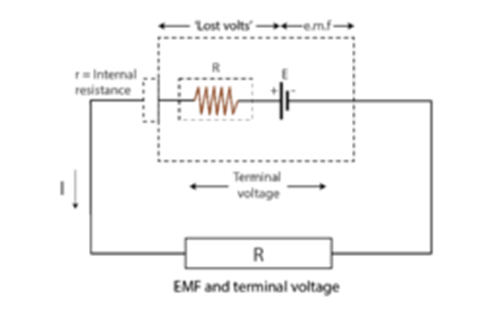Atomic Structure
- An atom has a positively charged nucleus and negatively charged electrons revolving around it.
- Valence electrons in metals are free to move within the conductor and constitute an electric current.
Charge
The charge is an intrinsic property of matter by virtue of which it can exert electromagnetic force.

Conductors and Insulators
A substance which offers comparatively less opposition to the flow of current is known as conductors and substances which offer larger opposition are insulators.
Electric Potential and Potential Difference
The electric potential at a point is defined as work done in bringing a unit positive charge from infinity to that point. The potential difference between two points is defined as the difference in electric potentials at the two given points.
Models of Electric Current
Electric Current(I)
Flow of electric charges is called electric current, i.e, I = Q / t
Electron sea model
Electric current in a solid conductor is due to drift of a ‘sea’ of free electrons, which are free to jump onto any neighbouring atom.

Drift velocity of Electron
Average velocity which an electron attains inside a metallic conductor due to the application of an electric field due to the potential difference.

Battery and its working
A cell is a source of potential difference, which is created inside it due to internal chemical reactions.
At anode: Cu(s)⇌Cu2+(aq)+2e−
At cathode: Ag(aq)+2e−⇌2Ag(s)
A combination of cells is called a battery.
Electric Circuit
Electric circuit and circuit diagram
- A closed-loop path which a current takes is called an electric circuit.
- Representation of an electric circuit through symbols is called a circuit diagram.

Resistance and Ohm’s Law
Ohm’s law
The current flowing through an ohmic conductor is directly proportional to the applied potential difference between the two ends of the conductor.

Resistance
Resistance is a measure of the opposition offered to the current flow in an electric circuit.
Factors affecting Resistance & How they affect
Resistance is:
- directly proportional to the length of the conductor.
- directly proportional to nature of the conductor.
- directly proportional to the temperature of the conductor.
- inversely proportional to the cross-sectional area of the conductor.
Resistivity
The electrical resistance offered by a substance of unit length and unit cross-sectional area is called resistivity.
Ohmic and Non-Ohmic resistors
Resistors which follow Ohm’s Law are called Ohmic resistors and those which do not follow it are called Non-Ohmic resistors.

Superconductors
Conductors which offer zero resistance to the flow of current are called superconductors.
Combination of Resistors
Combination of resistors
- Two resistors are said to be combined in series if they carry the same current.
- Two resistors are said to be combined in parallel if the same potential difference is applied to them.
Equivalent Resistance of a system of resistors
The equivalent resistance of two resistors is given as:
- In series, Req=R1+R2
- In parallel, 1 / Req= 1 / R1+1 / R2
EMF and Terminal Voltage
- EMF: The potential difference between the two terminals of a cell, when there is no current flowing through the circuit.
- Terminal voltage: The potential difference between the two terminals of a cell, when current is flowing through the circuit.

Electric Power and AC
Heating Effect of Current
Joule’s Law:
- Heat (H) ∝ square of the current (I).
- H ∝ Resistance of the given circuit.
- H ∝ Time (t) for which current flows through the conductor.
When a potential difference is established, it causes electrons to move, i.e. flow of current.
Electric Power
- The rate of doing work or rate of consumption of electrical energy is called Electric Power. If W is work done in time t, then P=W/t.
- S.I unit is Watt(W). One watt of power is consumed when 1 A of current flows at a potential difference of 1 V.
- The commercial unit of electrical energy is a kilowatt-hour (kWh).
- 1kWh=3,600,000J=3.6×106J
- Represented as P=I2R and P=V2/R
- One kilowatt-hour is defined as the amount of energy consumed when 1kW of power is used for 1 hour.